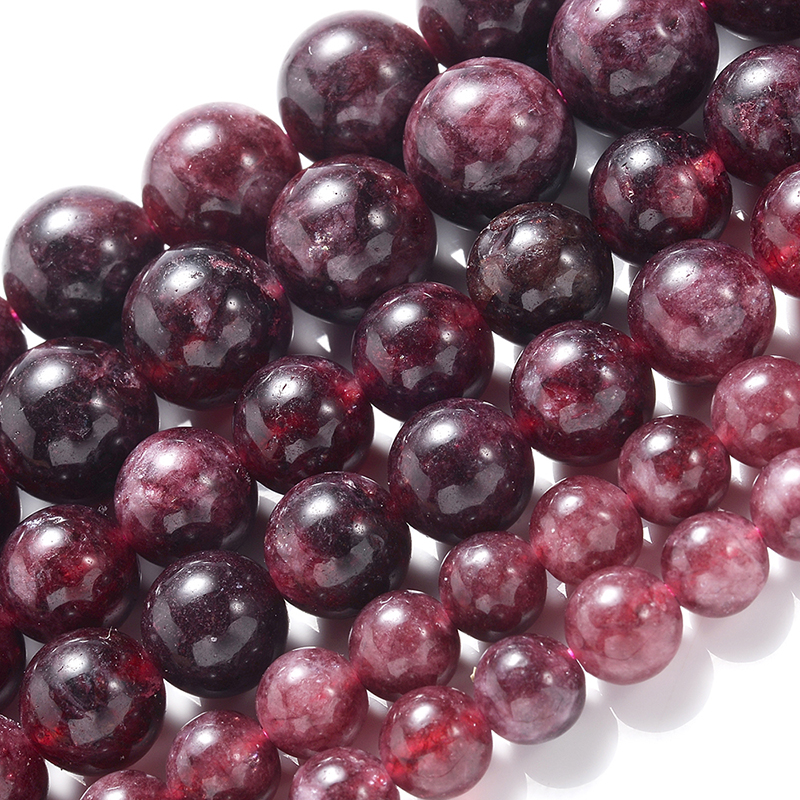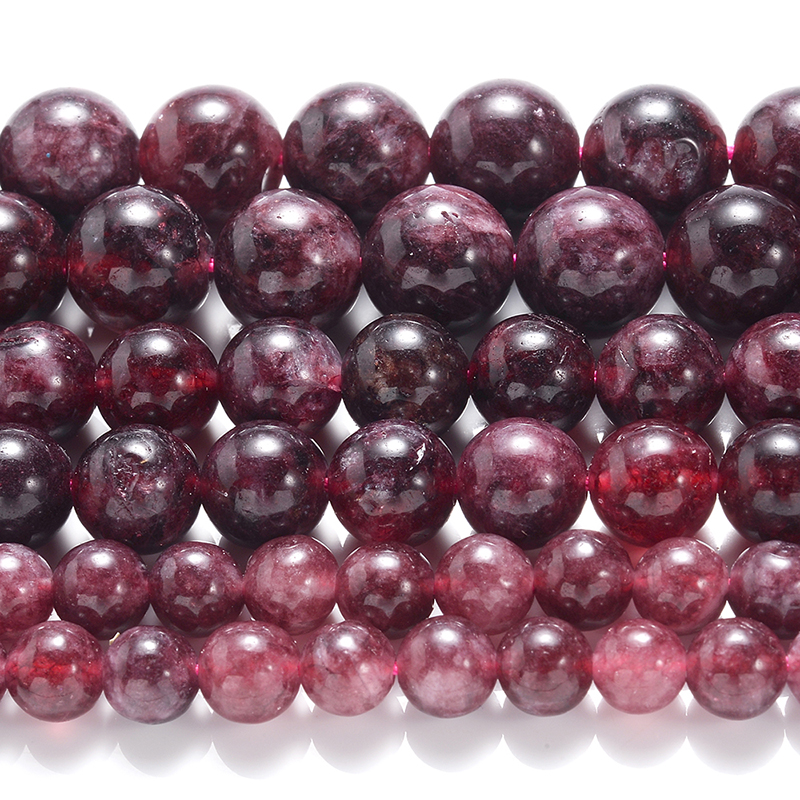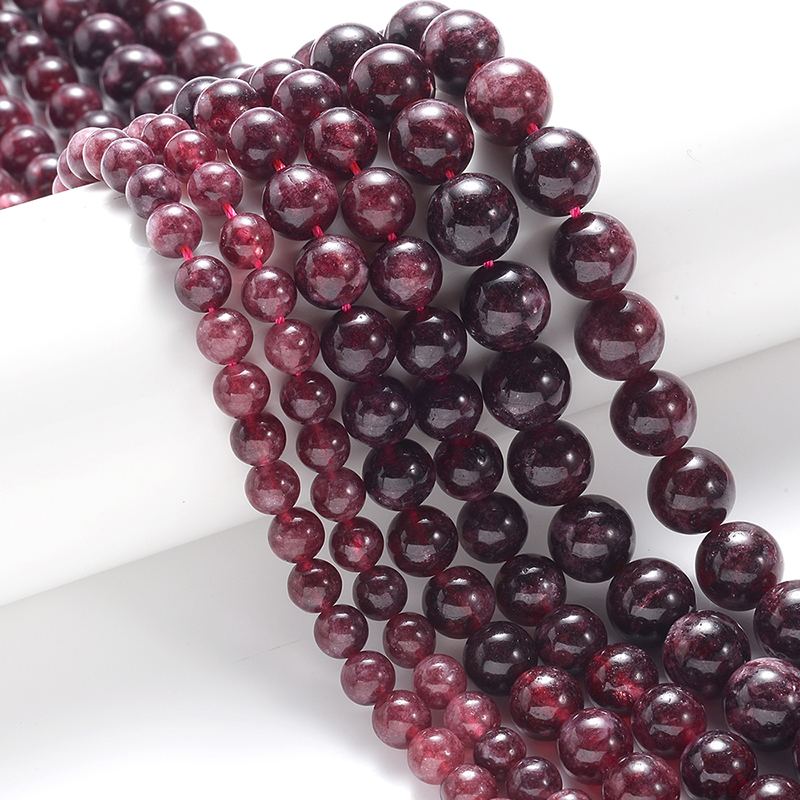Garnet is a January birthday stone, which has many varieties. The name “Garnet” comes from the Latin word “Granatus,” which means “like a seed.” It should be related to pomegranate because the color, shape, and size of pomegranate seeds are similar to garnet.
The word “Almandite” originates from the Latin word “Alabandine,” which is derived from the discovery of garnet by the ancient Roman philosopher Pliny in Alabanda, Turkey. Because it contains more iron, the color of almandine is dark red.
Almandine mainly occurs in schist, which is the product of regional metamorphism. It is widely produced in the world, but gem-grade crystals are very limited.
In the 18th and 19th centuries, it was trendy in the gem industry. The typical color of Almandite is dark red, maroon and purple red, and so on. Because the body color is too dark, resulting in reduced transparency.
The main producing areas of almandine are Brazil, India, Sri Lanka, Pakistan, Tanzania, Madagascar, the United States, and China. The inclusions of almandine are characterized by round or irregular crystal inclusions, sometimes accompanied by stress rings.
- Chemical composition: Fe3Al2 (SiO4) 3
- Transparency: transparent to translucent
- Gloss: glass luster to adamantine luster
- Refractive index: 1.76~1.82
- Optical characteristics: high positive protrusion, N=1.778~1.816. It is obviously homogeneous. It often has a sieve-like structure due to many mineral inclusions.
- Dispersion: 0.027
- Relative density: 4.05
- Mohs hardness: 7~8
- Color: brown, red, and black. It is light red and reddish brown in thin slices.
- Occurrence: Brown-red and pink almandines are mainly produced in metamorphic rocks such as schist, gneiss, amphibole, eclogite, and granulite. It can be changed into chlorite, epidote, etc.

Basic properties of almandine
It belongs to the equiaxed crystal system, a0=11.526A, Z=8. Spectral lines of main powder crystals: 2.589 (100), 1.595 (90), 1.539 (100), 1.259 (90), 1.071 (100), 1054 (90).
Morphology: The single crystal is usually a rhombic dodecahedron, tetragonal trioctahedron, or a polymer. Euhedral is relatively high, the largest diameter is up to 60 cm, and the aggregates are granular, cluster-like, and massive.
Inclusion: there are two groups of relatively sparse needle-like rutile inclusions parallel to the crystal edge, with an intersection angle of 70 ° and 110 °.
Some almandine contains three groups. If such inclusions are relatively dense, after being processed into arc-shaped gems, there can also be a four-star or six-star effect.
In addition to rutile, almandine can also contain solid inclusions such as ilmenite, zircon, apatite, magnetite, pyroxene, hornblende, and liquid inclusions such as water drop and short tube.
Physical property
The color of almandine is brown, dark red, dark brown-red, brown-red, violet, black-brown, black, etc. Among them, dark red almandine is the best, which is called “dark red garnet” or “precious garnet.”
It has a glass luster; some have a diamond luster and are transparent to translucent.
Absorption spectrum: there are three broad absorption bands in the yellow area (576nm), green area (527nm), and blue-green area (505nm), and there are one or several weak absorption lines in the blue area and orange area.
Others:
- It is light red to light brown under transmitted light, and the positive protrusions are extremely high.
- The refractive index is 1.776~1.830, usually 1.790.
- No cleavage.
- Homogeneous body, completely extinct, but abnormal interference color can be seen.
- The Dispersion is 0.024.
- The hardness is 7~7.5,
- The density is 3.93~4.17 g/cm, generally 4.05 g/cm.

Where does Almandite come from?
Almandine mainly occurs in regional metamorphic rocks and placers such as schist, amphibolite, gneiss, eclogite, granulite, etc., and is also distributed in other rocks such as contact metamorphic rocks, igneous rocks, etc.
The countries producing gem-grade almandine in the world include India, Sri Lanka, Afghanistan, Mongolia, Tanzania, Zimbabwe, Madagascar, Brazil, the United States, Italy, etc.
For example, the reddish-brown star almandine was produced in Idaho, the United States.
Gem-grade Almandine or its mineralization has been found in Xinjiang, Tibet, Sichuan, Guangdong, Guangxi, Hubei, Henan, Jiangsu, Hebei, Shanxi, Jilin, and other places in China.
In addition, almandine garnet was found in Antarctica.
Type of almandine
Gem-grade almandine can be roughly divided into five types according to different colors, special optical effects, and other arts and crafts characteristics, origin, and commercial significance.
- Ceylongamet, produced in Sri Lanka, was called “pure ruby garnet” in ancient times.
- Ceylonruby, produced in Sri Lanka, is dark-red and looks like ruby.
- Guamaccino, is orange-red and is produced in Italy.
- Capegamet, is red and yellow, produced in Cape of Good Hope, South Africa.
- Staralmandine, with radial (four-way or six-way) star effect, is produced in the United States, India, etc.
Similarly, the above classification of some almandine varieties according to different origins is actually a commodity classification.
Almandite value
The typical weight of Almandite is 1~20 carats. It will cost 20-50 USD per carat for almandine below 5 carats; 50-100USD per carat for the weight of almandine within 5-10 carats; 60-150 USD per carat for the weight of almandine within 10 to 20 carats,
Almandite is the cheapest ruby gemstone. When choosing almandine, you should choose the one whose body color is not too dark. The stronger the fire, the better.

Gem similar to Almandite
The difference between almandine and other garnet gemstones is first due to their different chemical compositions, as well as their differences in physical properties, and arts and crafts characteristics.
Other gemstones similar to almandine include ruby, zircon, etc. In addition to the essential or obvious differences in material composition, crystal structure, morphology, natural patterns, etc., they can also be identified according to their respective physical properties, arts and crafts performance and other significant differences.
The unique identification basis of ruby makes it completely distinguishable from almandine.
Red zircon belongs to the tetragonal crystal system,
- with pleochroism;
- the density is as high as 4.6~4.8 g/cm,
- the refractive index is 1.925~1.984,
- the birefringence is 0.059,
- the dispersion is 0.038,
- the absorption line is 635.5 nm,
- faceted edge with double shadow,
- strong “fire,”
So, We can easily distinguish it from almandine.
Conclusion:
Almandine is a kind of red-to-purple-red garnet. All types of garnets have a similar chemical formula. The chemical composition of almandine is iron aluminum silicate.
Natural almandine usually contains a little magnesium, but the iron element is the reason why almandine is red. The almandine is typically dark in tone, and can be subdivided into red, purplish-red, orange-red, and brownish-red.
The ore of almandine is often on the same plane, with needle-like crystals arranged at 70 and 110 degrees in parallel.
Therefore, the four-line star phenomenon is common in the almandine garnet.
Almandine is one of the most common types and a widely used gem in jewelry. In addition, because of its good hardness, low price, and easy availability, almandine is also used as an abrasive.
It is produced in Sri Lanka, Brazil, Madagascar, India, Idaho, and Australia. Other gemstones that are easy to mix with almandine are red gemstones such as Spessartine garnet, Majorite garnet, pyrope garnet, and ruby.
